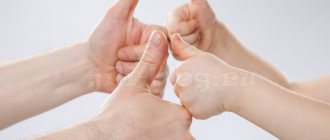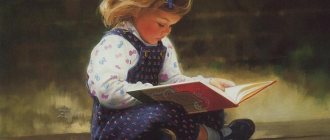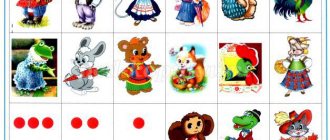How to develop a child's speech
The movements of the body and organs involved in speech production have common mechanisms, therefore the development of fine motor skills of the hands directly affects the development of speech. It is for this reason that finger exercises for the development of speech in children should take a strong place in your activities with your child.
Training finger movements will, as it were, prepare a platform for further speech development. You can start training your baby’s fingers within the first 5 months. We talk more about fine motor skills here.
Now let's see how you can help your child master their native speech, teach him correct pronunciation, constructing phrases and forming thoughts.
Remember: classes should be held in the most easy, fun and playful way possible. Then they will bring real benefits and bring real pleasure to both of you.
A set of measures for speech development (to be carried out at home):
- Development of fine motor skills
- Speech gymnastics
- Logorhythmics
We do not mention here such areas of work on speech development as speech therapy massage, special exercises for practicing various sounds, developing phonemic hearing, and some others. They are the area of application of exclusively professional knowledge and skills. Here it is better to trust a specialist rather than try to cope with this task yourself. Benefits for developing fine motor skills:
- Matryoshka dolls
- Velvet paper
- Plasticine
- Mosaic
- Laces
- Beans, peas
- Semolina
- Salty dough
- Counting sticks
- Multi-colored clothespins
- Beads
- Cloths with sewn buttons
- Stencils
- Massage ball
- Wooden construction sets
Fine motor skills:
- Passive gymnastics - massage for the development of fine motor skills.
- Active gymnastics - games for the development of fine motor skills: poems and nursery rhymes, finger games, finger theater.
Reading books
While reading, it is advisable to constantly use the questions “What is this?”, “Who is this?” (even if you have to answer them at first), questions activate the child’s mental detail and encourage him to talk.
Well, what is the best thing to read to a child at this age, you can find out here:
A SELECTION OF BOOKS FOR CHILDREN AGED 1-2 YEARS OLD. TALES AND POEMS
DEVELOPMENTAL BOOKS FOR CHILDREN 1-2 YEARS OLD
Passive gymnastics (massage)
It is better if an experienced professional shows you the massage technique, but you can master the simplest techniques yourself.
The massage is performed with one hand, the other holds the massaged hand. Session duration: 3 – 5 minutes; carried out several times a day.
Massage includes the following types of movements:
- Stroking - performed in different directions;
- Rubbing - differs from stroking with a greater force of pressure (the hand does not slide over the skin, but moves it);
- Vibration - applying frequent blows with the tips of half-bent fingers;
- Massage using a special ball - with the ball you need to make movements in a spiral from the center of the palm to the tips of the fingers; practical advice: you need to use a hard ball, that is, it should not be easily deformed (then the impact will be maximum);
- Flexion-extension of the fingers - the fingers are initially clenched into a fist, each in turn is extended and massaged from the side of the palm in a circular motion from the base to the tip.
We talk more about massage here.
Active gymnastics: games for developing speech using fine motor skills
Game aids:
- Butterflies made of colored paper
- Leaves of colored paper
- Pinwheel
- Cotton balls
- Paper boat
Games for children from 2 months:
- That's how different they are. Objects of various textures and shapes are placed in the child’s hand. The baby must grab the object and hold it for a while. This exercise develops not only motor skills, but also tactile sensations. It’s good if you comment on what is happening: “This ball is smooth,” “This hedgehog is prickly,” etc.
Games for children from 9 months:
- Prefabricated nesting dolls. First you need to collect one doll, then gradually complicate the game; after 2 years it should be a triple matryoshka.
- Pyramids. First you need to use a classic pyramid, the size of the rings of which decreases towards the top.
- Trace along the outline. You need to make cards with images of objects known to the baby, for example, a house, a tree, a car, and paste over their outlines with velvet paper. The essence of the game: an adult guides the baby’s finger along the contour and names the object. Then the outline is covered with beads or peas and the game is repeated.
- Cups and spoons. The child uses a spoon to pour sugar or semolina from one cup to another. You can also transfer beans, peas or nuts by hand.
- Modeling from plasticine. You need to start with a cylinder, and over time complicate the tasks: a ball, a carrot, a snake.
During the games, do not forget to comment on your actions and explain to your child everything that you do.
Games for children from 1 year:
- Strong palms. The child squeezes rubber toys. The best thing is the rubber hedgehog: the needles act like a massager.
- Mosaic. First you need to lay out simple shapes: paths, flowers, squares, and then move on to more complex ones: houses, cars, Christmas trees.
- Constructor. The size of the parts and the complexity of the design depend on the age of the baby: you need to start with the largest parts and the simplest structures, for example, building a turret.
- Beads. The size of the beads also depends on the age of the child. First, instead of beads, you can use balls from pyramids with round parts and string them on a thick cord; then the size of the parts must be gradually reduced, moving on to real beads. For the exercise, medium-sized beads already strung are used. The goal is to teach the child to lay out the outlines of objects from beads. For example, you can lay out a circle, square, heart, spiral, etc.
- Laces. Since lacing has different contents, it makes sense to play with the lacing process - for example, ask the child to sew a dress for his mother (lace-button) or lace shoes (lace-boot).
- Magic tray. Sprinkle a thin layer of semolina onto a tray and run the child’s finger over the cereal. The child is then shown how to draw various shapes. At the age of 2 - 3 years, you can draw numbers and letters.
- Multi-colored clothespins. The essence of the game is to teach the child to independently attach clothespins, and to make the game interesting, you can do this according to a thematic principle: rays to the sun, needles to the hedgehog, rain to the cloud, grass to the ground. Of course, for this you first have to make preparations. This is a rather difficult task for a child. Don't try to achieve results right away. To begin, take the baby’s hands in yours and do the exercise with him.
- Cinderella. You need to mix white and red beans and ask your child to sort them by color.
- Funny pictures. Spread the plasticine evenly over a sheet of cardboard and show your child how to lay out drawings using peas.
- Counting sticks. Show your child how to use counting sticks to lay out different shapes. It is advisable that the counting sticks are not smooth, but ribbed: this serves as an additional massage for the fingers.
- Little sculptor. Dough modeling (dough recipe: 1 cup flour, 1/2 cup salt, a little water). The advantage of dough over plasticine in this case is that the crafts can subsequently be used as toys.
- Fasten the button. You will need two pieces of thick fabric. On one of them, sew three buttons of different diameters, in the second, cut loops of appropriate size. First, show your child how to fasten the buttons, commenting on your actions: “We insert the large button into the large buttonhole, the medium button into the middle one, and the small button into the small one.” Then take the child's hands in yours and repeat the exercise. After this, you can invite the baby to try to fasten the buttons on his own. Don’t insist if the baby doesn’t want to or if he can’t do it. This is a very difficult exercise and requires practice to perform successfully.
- Stencils. It is recommended to start with stencils for internal tracing (it is easier for a child to trace inside than outside) and with the simplest shapes (circle or square). Practical advice: you can buy ready-made stencils, but it is better to make them yourself. The fact is that most standard stencils are small in thickness, and it is inconvenient for a child to trace them, since the pencil keeps slipping off. Therefore, the stencils must be quite voluminous. A good solution is to cut them out of a piece of linoleum or a shoebox.
Articulation exercises
One of the very first and very useful articulation exercises that a one-year-old baby can handle is blowing. Tasya learned to blow at the age of 1 year 3 months, a candle helped us with this. As soon as we got used to the candle, we began to be able to blow into a pipe and blow soap bubbles. So, how can you master the blowing skill:
- Blow out the candle;
- Blow a pipe;
- Blow through a straw into a glass of water to make the water gurgle;
- Blow soap bubbles;
- Blow on a paper butterfly tied to a string to make it fly;
- Blow off small pieces of paper placed on a plate.
Here are some other articulation exercises you can practice (from about 1.5 years old, some things may work out even earlier):
- "Hide and seek." First we show our tongue - stick it out as far as possible, then hide it, repeat this several times.
- "Watch." Move the tongue from side to side - left and right.
- "House". We declare that the baby’s mouth is home. The mother gently taps her finger on the cheek: “Knock, knock,” and the baby’s mouth opens. We say: “Bye! Bye!” and his mouth closes.
- "Yummy". We open our mouth slightly and lick ourselves: first we run our tongue along the upper lip, then along the lower lip.
- "Balloon". We puff out our cheeks and burst them with our fingers;
- "Fence". We show our teeth (“bar our teeth”) and say that the tongue is hidden behind the fence.
- “Brushing our teeth.” We show the teeth again, then with the tip of the tongue we slide first along the upper teeth, then along the lower ones.
- "Horse". We “clop” our tongues like horses.
- “They made a mistake.” We stand together in front of the mirror and begin to express ourselves: smile widely, frown, stretch out our lips.
Finger Theater
Finger theater is an exciting game that:
- Stimulates the development of fine motor skills;
- Introduces the child to the following concepts of shape, color, size;
- Helps develop spatial perception (the concepts of “right”, “left”, “next to each other”, etc.);
- Develops imagination, memory, thinking and attention;
- Helps develop vocabulary and activates speech functions;
- Forms creative abilities and artistic skills;
- Introduces basic mathematical concepts.
For children aged 1 – 2 years (using the example of the fairy tale “Kolobok”):
- First, introduce your child to the characters in the fairy tale. Invite your child to look at and touch the figures. Then put each character on your finger in turn and describe it.
- Introduce your child to the name of each finger on his hand. For example, you can say this: “I have a Kolobok sitting on my index finger.”
- Then act out a fairy tale for your child. Place the characters on your fingers and cross your arms. Start telling the story, raising your fingers with the characters as the action progresses. For example, the fairy tale “Kolobok” can be told as follows. Thumbs up with Grandma character. Tell your child that today this hero will bake Kolobok. Rhythmically tap the heels of your palms against each other without releasing your fingers. At the same time, say: “Grandma is kneading the dough.” Using the same principle, play up the appearance of each character.
For children aged 2 – 4 years (using the example of the fairy tale “Kolobok”):
- Ask your child if he remembers the fairy tale “Kolobok”. Remind him if necessary.
- Then ask your child to place the characters on the table in the order they appear in the story. At the same time, ask to characterize each of them according to the principle: “Grandma is old, kind, caring; Kolobok is round, ruddy, mischievous,” etc.
- Ask your child questions about the fairy tale. For example: “Why did grandma decide to bake Kolobok? Why did he leave his grandmother and grandfather? Who did he meet on the way?
- Then act out a fairy tale in front of the little spectator using a finger theater.
- At the end, ask your child to act out a fairy tale in front of you using a finger theater. If necessary, prompt him.
Viewing Doman cards or other material that expands a child’s horizons
I really love the Doman method - not the one in which parents chase results and the child sees nothing else except cards, but the version where parents show the child really interesting information without fanaticism. With this approach, the child loves the cards and looks at them with pleasure. He also tends to repeat the words he heard while watching!
During my lessons with my daughter, I noticed many times that her favorite cards encouraged her to say more and more new words. At the age of about a year, Taisiya tried, at least in monosyllables, to repeat after me the name of the picture she saw, or to depict it (for example, she snorted at the sight of a hedgehog, or pointed to a specific object). A little older, she began to repeat all the words in their entirety. Well, at 2 years old, when it was time to study fact-sentences, she easily memorized them and then gave them to us.
I don’t think it’s even worth talking about the fact that viewing Doman’s cards expands a child’s passive vocabulary.
Finger games for speech development
The essence of the finger motor skills lesson is to teach the child to use his fingers to depict some objects or living beings. In this case, all finger movements must be explained to the baby. This will help the child understand concepts such as “top”, “bottom”, “right”, “left”, etc. After the child learns how to do the exercises himself, you can try to act out scenes or short fairy tales, distributing the roles among yourself and your little actor (for example, a meeting between a hedgehog and a bunny in the forest). Here are some examples of such exercises.
- Finger game\
- . The index and middle fingers are straightened, the rest are clenched into a fist. Little man. “Run” with your index and middle fingers on the table.
- Finger game\
- . Clasp your hands, straighten the fingers of one hand and the thumb of the other. Cat. Connect the middle and ring fingers with the thumb, raise the index and little fingers up. Horned goat. The index and little fingers are straight, the thumb is on the bent ring and middle fingers. Butterfly. Cross your hands at the wrists and press your palms with the backs of your hands facing each other, fingers straight; palms with straight fingers make slight movements in the wrists - “butterfly flies.” Glasses. Fold the fingers of your right and left hands into rings and bring them to your eyes.
In addition to these examples, you yourself can come up with many interesting and entertaining exercises for your child to develop speech.
Final chords
We learn to speak clearly, competently and beautifully, first of all, for ourselves. The desire not to stand still, to develop, to set goals, to go towards them - all this gives us energy and makes us strong. And if we try to make our thoughts and feelings beautiful, then we will succeed. After all, thoughts are born from feelings, thoughts are clothed in words, and words are the components of our speech.
We will share our creative energy with children to help them overcome the problems that arise. How else?







